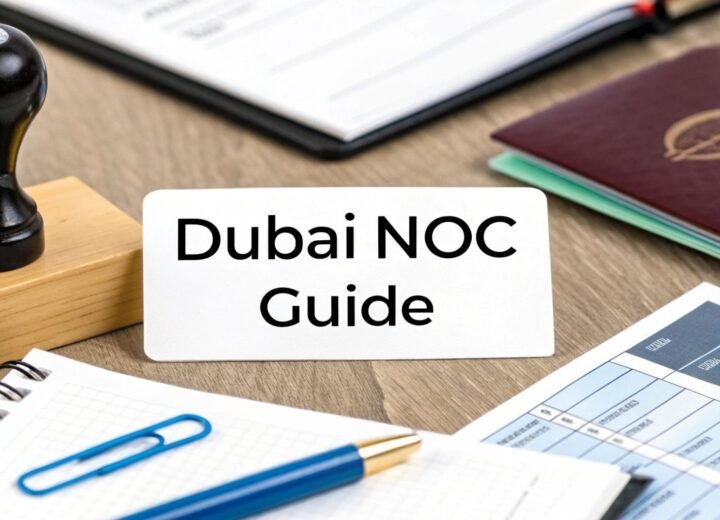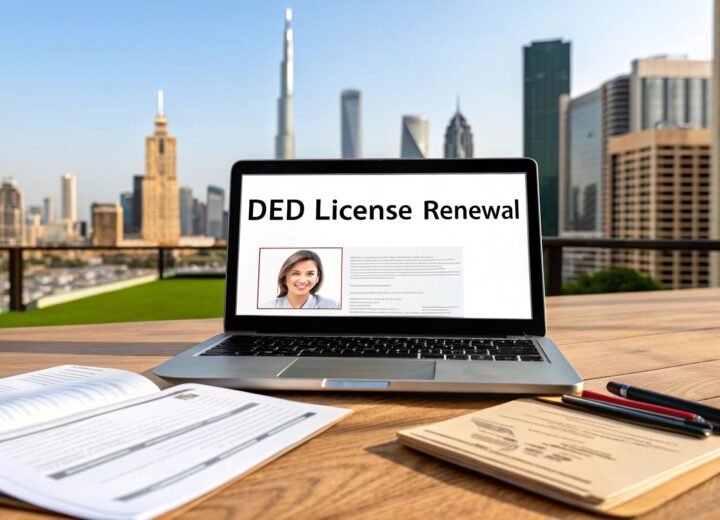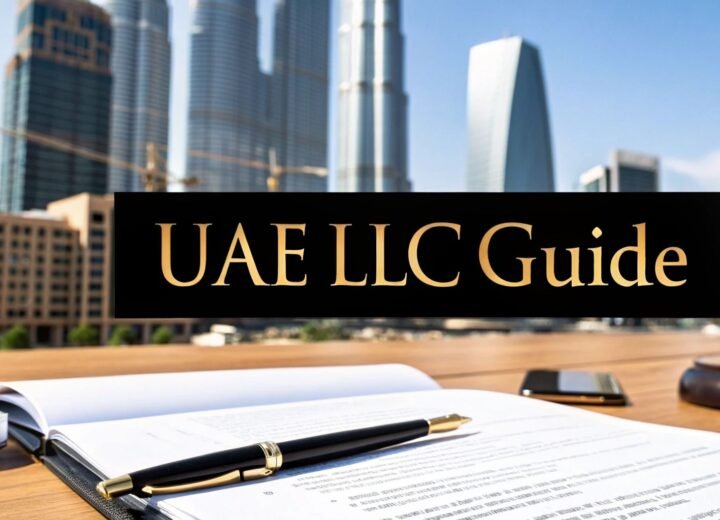Filing an application with the Ministry of Economy is how to register a trademark in the UAE, a process that grants you exclusive legal rights to your brand for 10 years. This is a critical step that shields your business identity, stops competitors from using similar branding, and formally establishes your brand as a valuable company asset.
Why Trademark Registration Is a Smart Move in the UAE
Securing your trademark in the United Arab Emirates is much more than just a legal box-ticking exercise; it’s a cornerstone of your business strategy.
In a market as dynamic and competitive as the UAE, your brand identity—the name, the logo, the slogans—is one of the most valuable things you own. Registering it officially transforms it from a simple idea into legally protected intellectual property.
Think of this protection as your first line of defence against copycats and counterfeiters. Without it, you’re leaving your brand exposed. Others could potentially piggyback on your hard-earned reputation to sell their own products, which confuses customers and waters down your presence in the market.
Building Trust and Brand Recognition
A registered trademark is essentially a badge of authenticity. When customers see the ® symbol next to your brand name, it signals that you're serious about your business and committed to quality. It's a small detail that goes a long way in building trust and loyalty.
This legal stamp of approval is crucial for anyone figuring out how to start a business in the UAE, as it sets the stage for future growth. A strong, protected brand makes it much easier to:
- Expand your business into new markets or other emirates like Dubai, Sharjah, or Abu Dhabi.
- Attract investors who view the trademark as a secured, tangible asset.
- Build a franchise model or license your brand to others, opening up new streams of revenue.
The Growing Importance of IP in the UAE
The UAE's dedication to strengthening its intellectual property laws is unmistakable. Just look at the numbers from the Ministry of Economy, which show a massive spike in trademark filings. This tells us that businesses have growing confidence in the system.
As of September 2024, an incredible 18,175 new trademarks were registered. That’s a 39% jump from the year before. This surge brought the total number of active trademarks in the UAE to 356,408, a figure that highlights the nation's commitment to fostering a secure environment for innovation. You can dig deeper into these IP trends over on the Ministry's official page.
Ultimately, registering your trademark is an investment in your brand's future. It provides the legal security needed to build customer trust, deter competitors, and unlock significant commercial opportunities across the region. As our specialists in Mainland and Freezone company formation always advise, protecting your brand from day one is non-negotiable for long-term success.
Laying the Groundwork for Your Trademark Application
A strong trademark application is built on solid preparation. I've seen too many entrepreneurs dive into the filing process without doing their homework, and it's a common reason for rejection that costs both time and money. Before you even think about submitting anything, there are three critical areas you absolutely must focus on: a thorough trademark search, correctly classifying your brand, and gathering all the right documents.

This foundational work is non-negotiable for a smooth journey on how to register a trademark in the UAE. Neglecting these steps can lead to an immediate refusal from the Ministry or, even worse, a legal challenge from another brand down the line. Let's break down exactly what you need to do to set your application up for success from day one.
Conducting a Comprehensive Trademark Search
The very first thing you need to do is ensure your proposed trademark is actually available for you to use. Many business owners make the mistake of only checking for direct name matches, but the UAE Ministry of Economy’s examination is much more detailed than a simple Google search.
Your search has to be comprehensive, looking for potential conflicts that are:
- Visually Similar: Does another logo use a similar design, font, or colour scheme?
- Phonetically Similar: Do the names sound alike when spoken, even if they're spelt differently? Think "Blu" vs. "Blue".
- Conceptually Similar: Do the marks convey the same idea or meaning, even with different words or images?
Failing to spot a pre-existing, similar mark is one of the top reasons I see applications get rejected. Imagine spending months building brand recognition only to find out you have to start over because your name infringes on someone else’s rights. A proper search is your insurance against this incredibly costly scenario.
Understanding the Nice Classification System
Once you're confident your mark is unique, you have to classify the goods or services it will represent. The UAE, like most of the world, uses the Nice Classification system. This is an international standard that organises everything into 45 distinct classes – 34 for goods and 11 for services.
This is a step where precision is absolutely key. You must select every class that accurately reflects your current and future business activities. For example, if you're launching a clothing brand that also plans to sell branded leather bags, you would need to register in two separate classes:
- Class 25: For clothing, footwear, and headgear.
- Class 18: For leather goods, including bags and wallets.
Picking the wrong class or failing to choose all relevant ones can severely limit the scope of your legal protection. It might leave a door wide open for a competitor to use a similar mark for a related product you simply forgot to cover.
Key Takeaway: Choosing the right Nice classes isn't just an administrative task—it defines the legal boundaries of your trademark's protection. Misclassifying your brand can make your registration ineffective right when you need it most.
Assembling Your Essential Documentation
With your search and classification sorted, the final preparatory step is to gather all the necessary paperwork. Having everything in order before you start the online application prevents delays and shows the examiner you're organised and serious. While the exact documents can vary slightly, a standard application will always require a core set of items.
Our specialists in corporate PRO services always give clients this checklist to ensure a seamless submission:
- Trademark Image: A high-resolution digital file of your brand name or logo (it needs to be in .JPEG format).
- Applicant Details: Full name, address, and nationality of the trademark owner, whether it's you as an individual or your company.
- Trade Licence Copy: For any corporate applicant, a valid copy of your UAE trade licence is mandatory. This is a core requirement for both mainland and free zone companies.
- Power of Attorney (POA): If you're using a trademark agent or a firm like ours to handle the process, you must provide a notarised and legalised Power of Attorney. This document formally authorises us to act on your behalf with the Ministry of Economy.
- Passport Copy: A clear copy of the passport of the person signing the POA.
Having these documents ready to go ensures that when you or your agent starts filing, there are no last-minute scrambles. This meticulous preparation is the hallmark of a successful application, getting you one step closer to securing your brand's identity in the vibrant UAE marketplace.
So, How Does the Official UAE Trademark Registration Process Work?
Once you’ve done your homework and laid the groundwork, you’re ready to dive into the official system. The journey to register a trademark in the UAE is a well-defined path managed by the Ministry of Economy, which is designed to bring legal clarity and fairness to everyone involved.
Think of it as a multi-stage process that moves from your initial submission to the final certificate, with a few important checkpoints along the way. Knowing this roadmap is crucial. Each step has its own purpose, timelines, and potential outcomes. Being prepared for what's ahead will make the whole experience feel a lot more manageable and less intimidating.
Kicking Things off: Submitting Your Application
Everything starts with filing your application online. The UAE government has modernised the system, so you or your agent will submit everything through the Ministry of Economy’s official portal. This is where all those documents you carefully prepared earlier finally come into play.
During this first filing, you have to be precise. You’ll need to upload a crystal-clear image of your trademark, fill out the applicant's details, and—most importantly—list the specific Nice Classification classes you've chosen. Any mistake or missing piece of information here can lead to serious delays, so checking every single field twice is time well spent.
The Formal Examination Phase
After your application is submitted and the initial fees are paid, it moves into the formal examination stage. This is where an official examiner at the Ministry of Economy takes a close look at your submission. Their main job is to make sure your application follows all the rules set out in the UAE's Federal Decree-Law No. 36 of 2021 on Trademarks.
The examiner will focus on a few key areas:
- Distinctiveness: Is your mark unique enough to separate your goods or services from the competition? Generic or purely descriptive words usually get rejected.
- Compliance: Does your mark go against public morals or include forbidden symbols, like official government emblems or religious icons?
- Conflict Check: The examiner runs their own search to see if your trademark is confusingly similar to any that are already registered or in the queue.
This phase can take a few months. If the examiner flags any issues, they might send you an "office action" or a conditional approval. You or your agent will then have a set amount of time to respond. It goes without saying that a clean, well-prepared application has a much better chance of sailing through this stage without any hiccups.
Expert Insight: Don't mistake the examination phase for a simple formality. It's a proper legal review. If an examiner raises a query, you'll need to provide a clear and persuasive legal argument in response. This is exactly where having professional support from corporate PRO services can be a game-changer in overcoming potential objections.
Publication and the Opposition Period
If your application successfully passes the examination, it’s not registered just yet. Instead, it enters a crucial public-facing stage. The Ministry will give your mark the green light for publication in the Official Gazette.
This publication triggers a 30-day opposition period. During this month-long window, any other business or individual who feels your trademark infringes on their existing rights can file a formal objection. It’s a safety measure built into the system to prevent market confusion and protect the rights of brand owners who were there first.
If someone does file an opposition, the registration process hits pause. You'll be officially notified and given 30 days to submit a counter-statement. The Ministry then steps in to decide the matter. If that 30-day window closes with no objections, your application is clear to move to the final step.
This visual breaks down the core stages from submission to issuance, giving you a clear picture of the process.
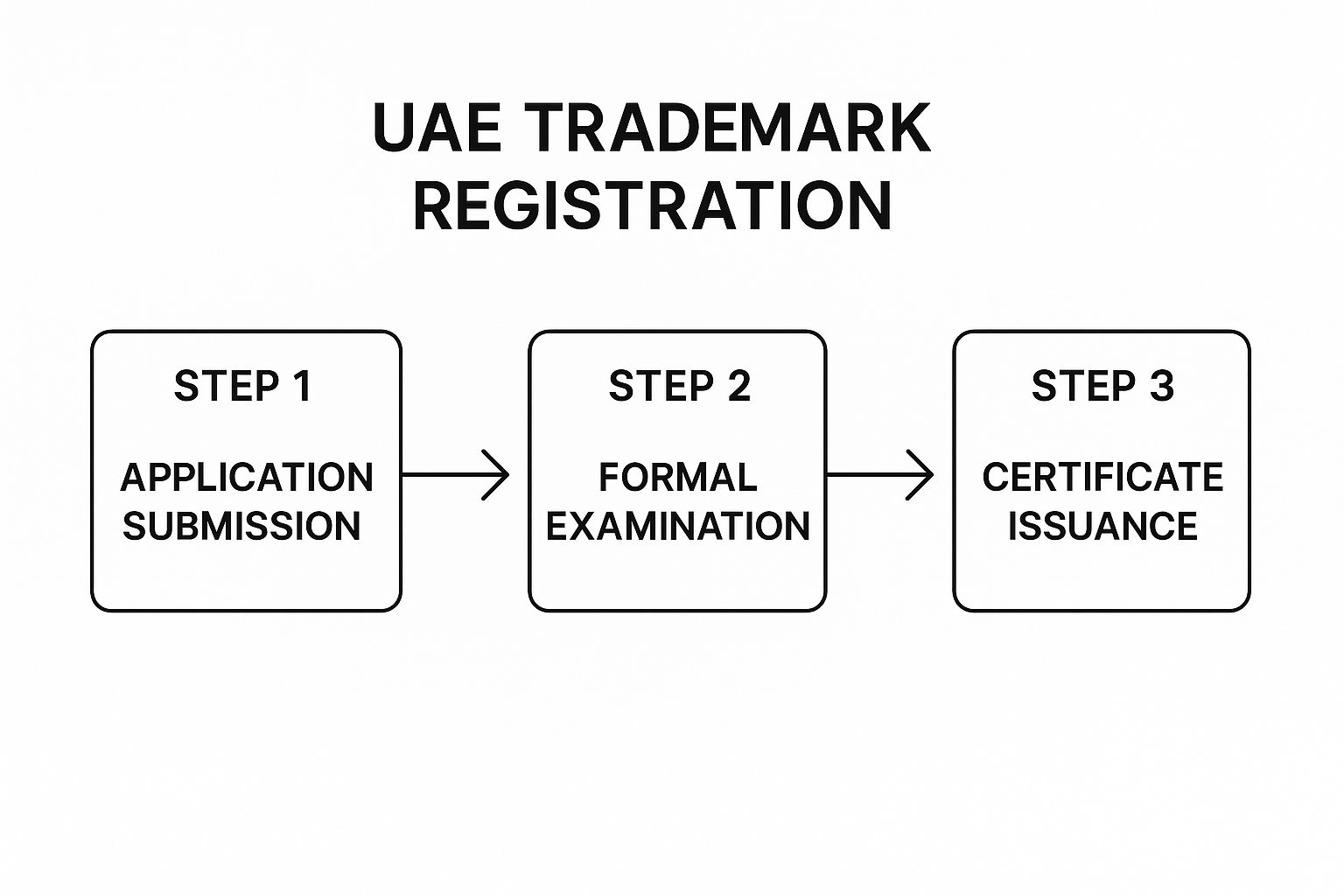
As you can see, the journey involves distinct, sequential phases. Each one is a critical checkpoint before you can move on to the next.
Final Registration and Getting Your Certificate
Congratulations! If your mark made it through the opposition period unchallenged, you're at the final hurdle. At this point, you just need to pay the final registration fees. Once that payment is confirmed, the Ministry of Economy will issue the official trademark registration certificate.
This certificate is your official proof of ownership. It legally confirms you have the exclusive right to use that mark in the UAE for the goods and services you listed in your application. It’s a powerful asset that formalises your brand’s legal protection.
The whole process is managed by the Ministry of Economy, from the initial check to final renewal. After successful registration, your trademark is protected for 10 years and can be renewed indefinitely. The UAE's system also lets you file under multiple classes at once, which is great for building a comprehensive protection strategy. For more on the UAE's dedication to IP rights, you can check out insights on Trading Economics.
The journey from filing to registration involves several key milestones. Here’s a quick overview of what to expect and how long each step typically takes.
UAE Trademark Registration Stages and Timelines
| Stage | Description | Estimated Timeline |
|---|---|---|
| Application Filing | Submitting the completed application and required documents via the Ministry of Economy's portal. | 1-2 Business Days |
| Formal Examination | An official examiner reviews the application for compliance with UAE trademark law and distinctiveness. | 2-4 Months |
| Publication & Opposition | If approved, the trademark is published in the Official Gazette for a 30-day opposition period. | 30 Days |
| Registration & Issuance | If no opposition is filed, the final registration fees are paid and the certificate is issued. | 2-4 Weeks |
These timelines are estimates, of course. A straightforward application might move faster, while one facing objections will naturally take longer.
Understanding Your 10-Year Validity
Your UAE trademark registration is valid for 10 years, starting from the date you filed your application, not the date it was registered. This gives you a solid decade of protection, but it isn't permanent unless you maintain it.
To keep your rights active, you need to apply for renewal within the final year of that 10-year term. The law does offer a six-month grace period after the expiry date to renew, but this usually comes with late fees. As long as you keep renewing it every ten years, your trademark protection can last forever, safeguarding the brand you're building—whether it's for a mainland or freezone company—for generations to come.
Breaking Down the Costs and Required Paperwork
Getting your trademark application right in the UAE boils down to two critical elements: the fees and the paperwork. To successfully register your trademark, you need to understand that each step has its own price tag and a specific list of documents. From the initial filing to the final certificate, getting any detail wrong can lead to frustrating delays or even an outright rejection from the Ministry of Economy.
Let's walk through the financial and administrative side of things. We'll break down every fee you can expect and give you a clear checklist of the documents needed, so you're fully prepared for a smooth process.
A Clear Look at Trademark Registration Fees
Budgeting for your trademark isn't just a one-off payment. The total cost is spread across several official government fees that you'll pay at different stages. It's smart to account for all of them to avoid any last-minute surprises.
Here are the main costs you should plan for:
- Filing Fee: This is what you pay upfront to get your application submitted to the Ministry of Economy. Think of it as the administrative cost to get your trademark into the system for review.
- Publication Fee: Once your application passes the initial examination, this fee covers publishing your trademark in the Official Gazette. This is a crucial step that kicks off a 30-day window for anyone to oppose it.
- Final Registration Fee: After the opposition period ends without any challenges, you'll make this final payment. In return, you get your official trademark registration certificate, which legally solidifies your ownership.
A key point to remember is that these fees are calculated per class. If your brand operates in multiple categories under the Nice Classification system—say, a café that sells both coffee (Class 30) and branded t-shirts (Class 25)—you'll have to pay separate filing and registration fees for each class. This is where costs can quickly add up, so classifying your trademark correctly is essential for both protection and your budget.
A common mistake we see entrepreneurs make is underestimating the total investment. For a single-class application, you should realistically budget around AED 7,500 – AED 9,500 in official fees alone. It's also wise to factor in professional service fees if you hire an agent to manage the submission and follow-ups—it's an investment in getting it done right the first time.
Assembling the Correct Documentation
Perfect paperwork is the foundation of a successful trademark application. The Ministry of Economy is very particular about its requirements, and something as simple as a missing or poorly prepared document can stall the entire process. The list of required documents also changes slightly depending on who is applying—an individual or a company.
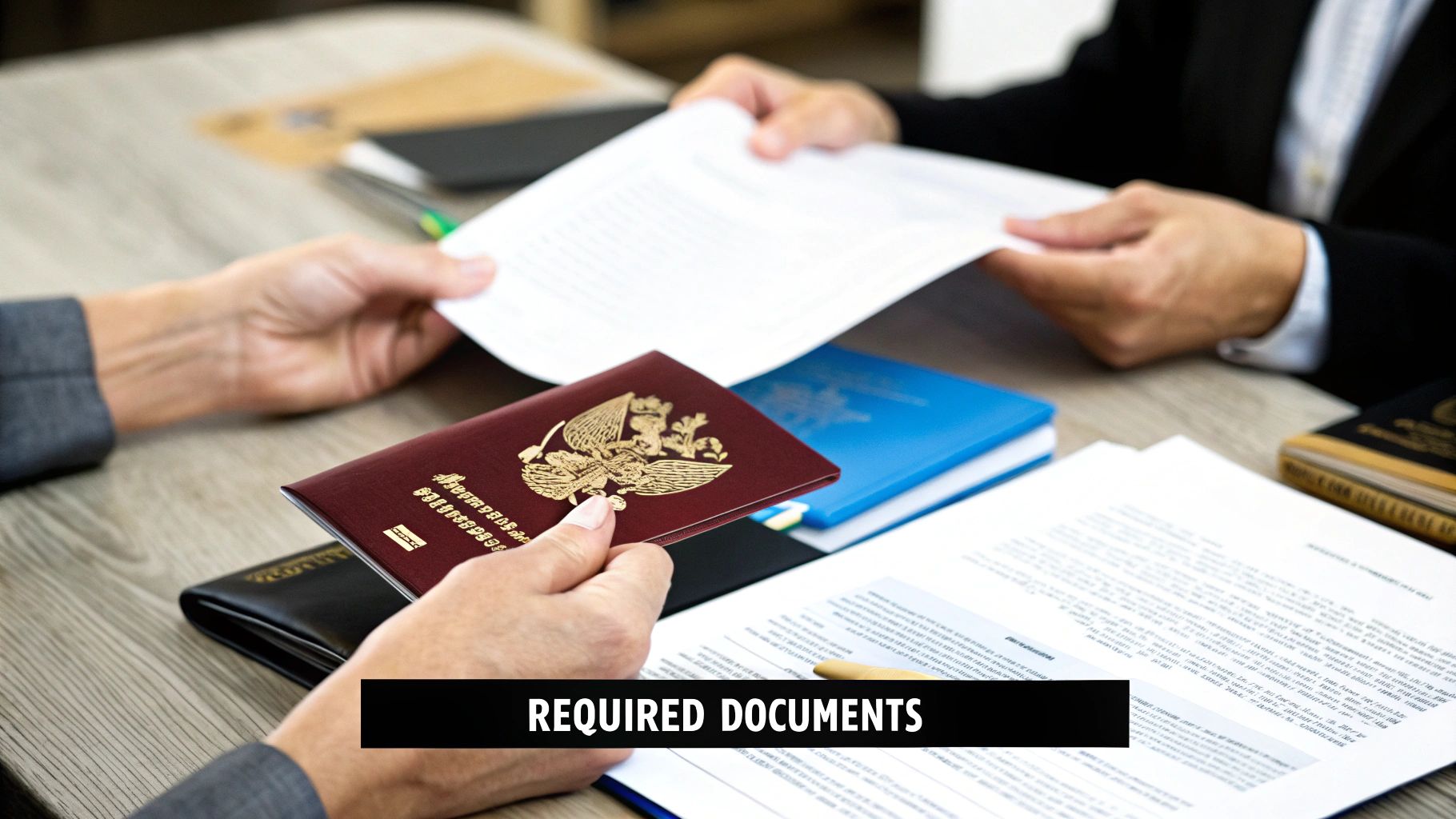
As specialists who handle corporate PRO services daily, we always stress the importance of preparing these documents with care. For any business applying, a valid trade licence is non-negotiable; it's the official proof of your legal status in the UAE. If you're unsure about this, our team can guide you through the process of getting a Dubai trade license.
To make sure your submission is complete from day one, here's a side-by-side comparison of what each type of applicant needs.
Required Documents for UAE Trademark Registration
Getting your documents in order before you start is half the battle. This table breaks down exactly what you need, whether you're applying as an individual or on behalf of a UAE-based company.
| Document | Individual Applicant | Corporate Applicant (UAE-Based) |
|---|---|---|
| Trademark Specimen | Required (A clear, high-resolution digital image of the logo or wordmark in JPEG format.) | Required (A clear, high-resolution digital image of the logo or wordmark in JPEG format.) |
| Applicant's Passport | Required (A clear, valid copy of the applicant's passport.) | Required (A clear, valid copy of the passport of the authorised signatory.) |
| UAE Trade Licence | Not Applicable | Required (A valid copy of the company's trade licence issued from any UAE emirate.) |
| Power of Attorney | Required (A notarised and legalised POA if appointing a trademark agent to act on your behalf.) | Required (A notarised and legalised POA if appointing a trademark agent to act on your behalf.) |
If you're a foreign company, pay close attention to the Power of Attorney. It must be legalised right up to the UAE embassy in your home country and then attested by the UAE Ministry of Foreign Affairs here. This is a non-negotiable legal step that proves your agent is authorised to represent you, and it's absolutely fundamental to the success of your application.
Common Pitfalls and Pro Tips for a Smooth Registration
Getting a trademark registered in the UAE can be a tricky business. I've seen countless entrepreneurs get tangled up in the process, where even a tiny mistake can cause major delays or, worse, an outright rejection. Based on years of helping businesses protect their brands, we've pinpointed the most frequent missteps that derail applications.
Knowing how to sidestep these issues from the get-go will save you a world of time, money, and frustration. And it’s not just about the trademark application itself; being aware of common business pitfalls in general can really help you build a solid foundation for your company in this competitive market.
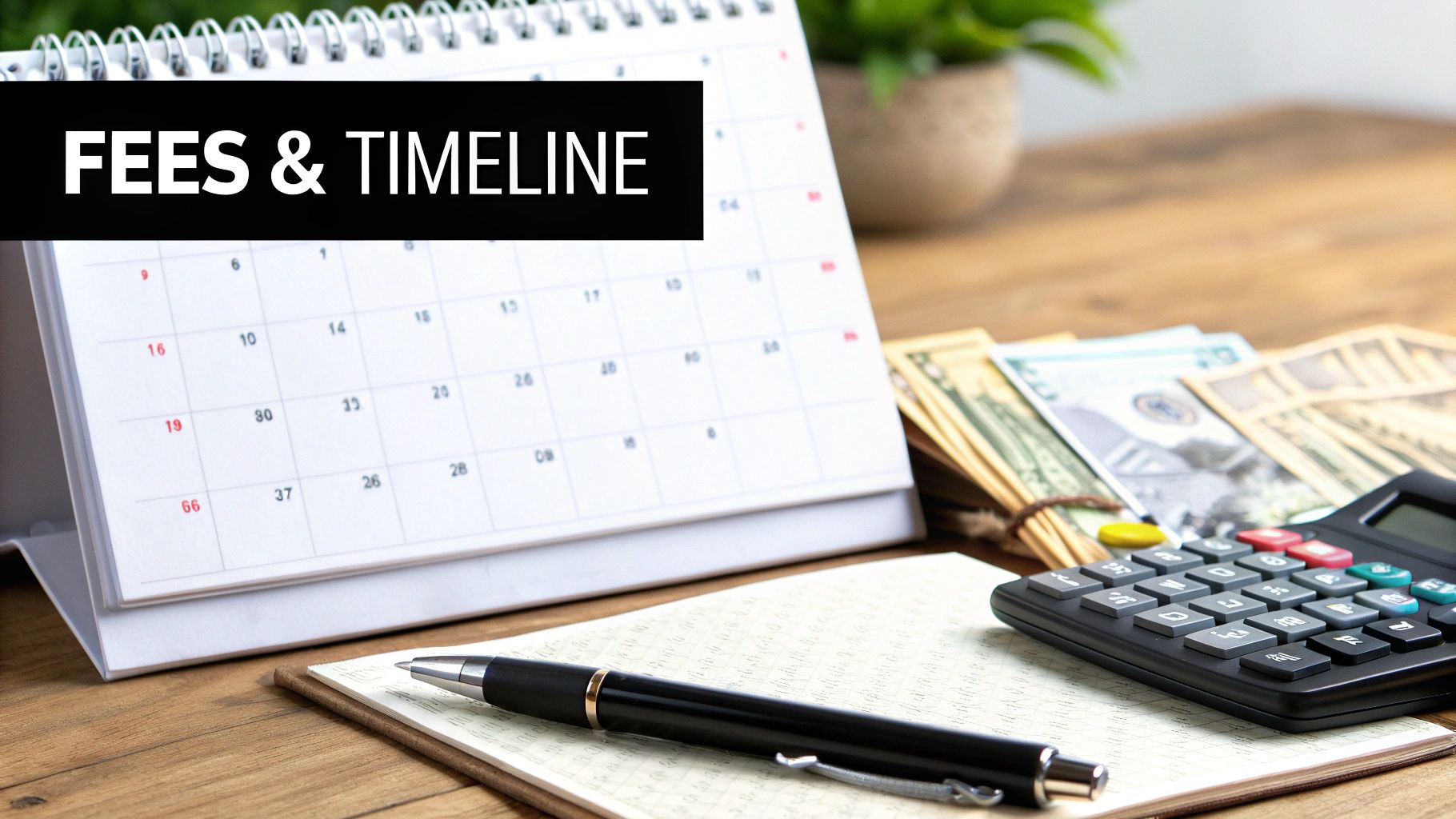
Overlooking a Thorough Search
One of the biggest mistakes we see is a half-hearted trademark search. A quick Google search or a simple check for an exact name match just won't cut it. The Ministry of Economy's examiners are trained to look for anything that could confuse a customer, including names that sound alike or logos that look similar.
For instance, you might think your logo with a stylised falcon is unique. But if another brand in the same category already has a similar bird design registered, your application could be flagged and rejected—even if the brand names are completely different. That oversight sends you right back to the beginning.
Choosing the Wrong Classes
Another classic blunder is messing up the classification of your goods and services. The Nice Classification system is incredibly specific, and a mistake here can leave huge gaps in your legal protection. A common error is only registering for what you sell today, completely forgetting about what you might sell tomorrow.
Imagine you launch a brand of premium dates, which falls under Class 29. But you have a vision to introduce a line of branded coffee (Class 30) down the road. If you only register in Class 29, nothing stops a competitor from legally using a similar brand name for their coffee. That can create massive confusion in the market and seriously dilute your brand identity.
Pro Tip: Always think five years ahead. It's far more cost-effective to register your mark across all potential classes of interest right from the start. This secures your brand for future growth and locks out competitors before they can get a foothold.
Submitting a Weak Trademark
It's also very common for the Ministry to reject a mark simply because it isn't distinctive enough. Generic or purely descriptive terms are almost guaranteed to be refused. You can't trademark something like "Dubai Quality Coffee" because words that just describe a product's quality, features, or where it's from can't be monopolised.
Your mark needs to be unique enough to truly distinguish your products or services from everyone else's. That's a core principle of trademark law here in the UAE.
Here are a few practical tips to keep your application on track:
- Get Professional Help: Trademark law has a lot of complex details. Our team offers cost-effective business setup solutions, including PRO services that are specifically designed to manage the entire registration, ensuring everything is compliant and saving you from expensive mistakes.
- Respond Promptly: If you get a query from the examiner, don't wait around. Delays can lead to your application being marked as abandoned. With our 24/7 support service, we're always on standby to handle any official communications for you.
- Keep Meticulous Records: Always keep copies of everything—your application, all correspondence, and payment receipts. You'll be thankful you have a clear paper trail, especially if someone files an opposition against your mark.
By avoiding these pitfalls and leaning on expert advice, your chances of a smooth and successful registration go way up. For international entrepreneurs, securing your trademark is just one piece of the puzzle. To learn more about setting up a solid presence in the UAE, check out our guide on UAE investor visa requirements.
Your UAE Trademark Questions Answered
Navigating the details of trademark registration in the UAE can feel complicated, and it’s natural to have questions. We see the same queries pop up time and again from entrepreneurs and established business owners alike.
To help you get some clarity, we've put together answers to some of the most common questions we get. Think of this as your go-to guide for direct, practical information so you can move forward with confidence.
How Long Is a Trademark Valid and Can It Be Renewed?
Once registered, your trademark in the UAE is protected for 10 years from the day you first filed the application. That's a full decade of exclusive rights to your brand identity.
But you have to stay on top of it. You can apply to renew your trademark during the final year of its protection period. If you miss that window, there's a six-month grace period after the expiry date, but expect to pay late fees. The good news? As long as you keep renewing it every 10 years, your trademark protection can last indefinitely.
What Happens If Someone Objects to My Trademark Application?
This is a critical stage in the process. After your application clears the initial examination by the Ministry, it gets published in the Official Gazette. This kicks off a 30-day opposition period where anyone can legally challenge your right to register the mark.
If an objection is filed, you’ll be notified and given 30 days to formally respond with a counter-statement. The dispute could even escalate to a hearing at the Ministry of Economy. This is where things get serious, and having an expert on your side, like a professional corporate PRO, is invaluable to navigate the legal arguments effectively.
Can I Register a Trademark in the UAE as a Non-Resident?
Absolutely. Foreign individuals and international companies can register trademarks in the UAE on the same terms as local applicants. Your nationality or place of residence doesn't create any barriers to owning intellectual property here.
There is one important rule, though. If you're applying from abroad, you must appoint a licensed UAE-based trademark agent to handle the filing for you. This means providing them with a properly notarised and legalised Power of Attorney, which gives them the authority to act on your behalf.
Our specialists in Mainland and Freezone company formation do this all the time for international clients. We can manage the entire Power of Attorney legalisation, making sure your application ticks all the local boxes without you having to deal with the complexities from overseas.
What Kinds of Marks Cannot Be Registered in the UAE?
The UAE's trademark law is very specific about what won't be accepted. Knowing these rules from the outset can save you from an immediate rejection and wasted fees.
Here are the main types of marks that are prohibited:
- Generic or Descriptive Terms: You can't trademark words that simply describe what you sell. Think "Fresh Juice" for a juice bar or "Fast Delivery" for a courier. They aren't distinctive enough.
- Marks Contrary to Public Morals: Any branding considered offensive or against public order and morals will be rejected outright.
- Official Emblems and Religious Symbols: This includes national flags, emblems of organisations like the Red Crescent, and symbols that are purely religious in nature.
- Deceptive Marks: Any trademark that could mislead the public about the product's origin, quality, or nature is strictly forbidden.
Making sure your mark is unique and steering clear of these categories is a fundamental first step.
Getting your trademark registered in the UAE requires careful planning and a solid grasp of local regulations. At PRO Deskk, we offer expert, cost-effective support to protect your brand.
✅ Specialists in Mainland Company Formation in Dubai, Sharjah & Abu Dhabi
✅ Specialists in Freezone Company Formation across the UAE
✅ Specialists in Golden Visa on Property and Investor Visa
✅ Specialists in Corporate PRO Services and Attestation Services
✅ 24/7 Support Service – Always here when you need us
✅ Cost-Effective Business Setup Solutions tailored to your needs
✅ Enjoy UAE Tax Benefits for International Entrepreneurs
📞 Call Us Now: +971-54-4710034
💬 WhatsApp Us Today for a Free Consultation and let us help you secure your most valuable asset. Learn more about our full suite of services at https://prodesk.ae.

